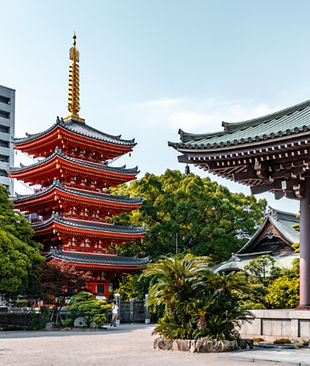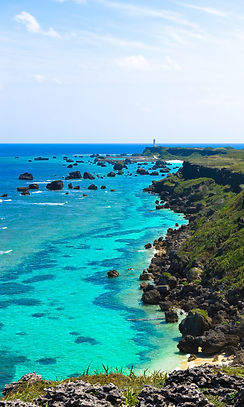Southern Japan
Why Travel to Southern Japan?
Southern Japan is where tradition, tropical beauty, and cultural depth come together. From the historic samurai streets of Kyushu to the pristine beaches of Okinawa, the south offers a warmer, more laid-back side of Japan. Here, you can explore ancient temples in Nagasaki, soak in steaming onsen in Beppu, or hike volcanic landscapes around Mt. Aso. Southern Japan is rich in heritage, with a strong regional identity reflected in its unique festivals, architecture, and welcoming hospitality.
Each season brings its own charm: cherry blossoms arrive earlier in the south, while summer invites you to enjoy island hopping, snorkeling, and beachside relaxation in Okinawa’s subtropical waters. Autumn lights up the forests and temple gardens in places like Kumamoto and Miyazaki with vivid foliage, and winter stays mild—perfect for sightseeing without the chill. With fewer crowds, distinctive cuisine (think rich tonkotsu ramen and fresh island seafood), and a slower pace, Southern Japan is ideal for travellers seeking beauty, warmth, and cultural richness beyond the usual tourist trail.

_edited.png)
_edited.jpg)
⛴️Hop Across the Sea – Ferry to South Korea
One of Fukuoka’s most unique advantages is its close proximity to South Korea — in fact, it’s one of the few places in Japan where you can catch a ferry and be in another country in just a few hours.
Regular ferries connect Fukuoka’s Hakata Port to Busan, South Korea’s vibrant coastal city. You can choose the high-speed JR Kyushu Beetle ferry (approx. 3 hours) or the larger Camellia Line ferry (overnight or day options, approx. 6–7 hours). Both options offer stunning views of the Tsushima Strait and are popular with adventurous travelers looking to combine Japan and Korea in one trip.
Whether you’re planning a short international detour or starting a broader East Asian adventure, Fukuoka makes it easy to experience two cultures in one journey.
Tip: Be sure to check visa requirements, bring your passport, and arrive early for customs processing.
_edited.jpg)
Fukuoka – The Heartbeat of Kyushu
Ramen, Festivals, Street Food & Coastal Cool
Fukuoka, Japan’s vibrant southern gateway, is a city where centuries-old shrines sit side by side with glitzy shopping centers, and the streets hum with the scent of sizzling ramen. As the largest city on Kyushu, Fukuoka blends historic charm with a youthful, relaxed energy. It's famous for its tonkotsu (pork bone) ramen, breezy bayside views, and yatai — cozy, open-air food stalls that come alive after dark.
Spend your day exploring the serene Ohori Park, the ruins of Fukuoka Castle, and modern icons like Canal City Hakata, a huge shopping and entertainment complex. Head to Fukuoka Tower for panoramic views, or take a short trip to Dazaifu Tenmangu Shrine to discover spiritual tradition surrounded by plum blossoms. When night falls, follow the locals to the Nakasu riverside for a street food experience like nowhere else in Japan.
Whether you’re soaking up the summer beach scene in Momochi, hopping a ferry to nearby Itoshima’s beaches and cafes, or simply slurping ramen at a stand-up shop in Hakata, Fukuoka invites you to dive into Kyushu’s warm, delicious soul.
🌸Travel Tips – Fukuoka
Best Time to Visit:
-
Spring (March–May) for festivals and cherry blossoms at Maizuru Park
-
Autumn (October–November) for comfortable weather and colorful foliage
-
Summer is lively with beach events, though hot and humid
Don’t Miss:
-
Fukuoka Tower: For sweeping views over the bay and cityscape
-
Canal City Hakata: Entertainment, shopping, and a ramen-lover’s paradise
-
Kushida Shrine: Cultural heart of the city and home to the Hakata Gion Yamakasa Festival
Hidden Gems:
-
Yatai Food Stalls: Try gyoza, skewers, and ramen at these iconic open-air stands
-
Itoshima Peninsula: Beaches, surf spots, and scenic café culture, just an hour away
-
Dazaifu Tenmangu Shrine: A short train ride leads to this ancient spiritual site
Suggested Areas to Stay
-
Hakata: Best for first-timers, close to transport, shopping, and tons of dining options–
-
Tenjin: Bustling and stylish, great for nightlife, shopping, and local energy
-
Nakasu-Kawabata: Right by the river, full of history and close to yatai action.
Nagasaki – Bridges Between Worlds
History, Peace & Portside Beauty
Tucked into the hills and harbors of Kyushu, Nagasaki is where East meets West, and history lives side by side with quiet beauty. Once Japan’s only window to the outside world during its centuries of isolation, the city carries a deeply international feel — from Dutch-style buildings in Dejima to the solemn but powerful Atomic Bomb Museum and Peace Park.
Ride the scenic tram to hillside lookouts, wander the lantern-lit Shianbashi district, and explore Glover Garden, with its blend of Victorian mansions and ocean views. Nagasaki is known for its unique fusion cuisine too — try champon noodles, Portuguese-influenced castella cake, and Japanese-Chinese hybrids you won’t find elsewhere.
🌸Travel Tips – Nagasaki
Best Time to Visit:
-
March to May for spring flowers and clear skies
-
October for the stunning Kunchi Festival and mild weather
Don’t Miss:
-
Atomic Bomb Museum & Peace Park: A moving, powerful experience
-
Glover Garden: Western-style homes with hilltop views
-
Nagasaki Lantern Festival (February): One of Japan’s most beautiful winter events
Hidden Gems:
-
Hashima Island (Gunkanjima): The eerie “Battleship Island” ruins off the coast
-
Mt. Inasa Night View: One of Japan’s top three nightscapes
-
Dejima: The former Dutch trading post turned heritage site
Suggested Areas to Stay:
-
Nagasaki Station Area: Great for sightseeing and transport
-
Shianbashi: Local nightlife, dining, and traditional charm
.png)


.png)
.png)
.png)
Kagoshima – Volcano Views & Samurai Spirit
Natural Drama, Hot Springs & Island Hopping
Kagoshima, often called the "Naples of Japan," is a city with a fiery heart — quite literally, thanks to Sakurajima, the active volcano that smokes calmly across the bay. This southern Kyushu city is deeply rooted in samurai tradition, yet offers relaxing hot springs, incredible nature, and views that change with every angle of the water.
Take a ferry to get closer to Sakurajima’s lava fields, explore the Sengan-en Garden with its traditional home and volcano backdrop, and dine on Kurobuta pork — Kagoshima’s rich local delicacy. It’s also the gateway to the lush, otherworldly island of Yakushima, a UNESCO World Heritage site covered in ancient cedar forests and mossy hiking trails.
🌸 Travel Tips – Kagoshima
Best Time to Visit:
-
Spring (March–May) for perfect garden and volcano views
-
Autumn (September–November) for island adventures and cooler hiking
Don’t Miss:
-
Sakurajima: Get up close to Japan’s most iconic volcano
-
Sengan-en Garden: Stunning gardens, a samurai villa, and bay views
-
Ibusuki Sand Baths: Relax as you're buried in warm volcanic sand
Hidden Gems:
-
Yakushima Island: Dreamy hiking, waterfalls, and ancient cedar trees
-
Chiran Samurai Residences: Preserved warrior homes with tranquil gardens
-
Shiroyama Observatory: For panoramic views of city and volcano
Suggested Areas to Stay:
-
Tenmonkan: Central Kagoshima, perfect for food, shopping, and trams
-
Sakurajima Ryokan: For those who want to wake up to volcano views
-
Ibusuki: Hot spring town with coastal charm
Okinawa – Japan’s Island Paradise
Beaches, Blue Waters & Island Culture
Okinawa is Japan — but not as you know it. This island chain stretches across the East China Sea and offers a tropical escape filled with coral reefs, turquoise beaches, and a culture distinct from the rest of the country. Influenced by its Ryukyu Kingdom roots, Okinawa blends laid-back island vibes with a proud, independent spirit.
Swim, snorkel, or simply relax on white-sand beaches. Explore Shurijo Castle (rebuilt after fire) to uncover royal history, visit Churaumi Aquarium, and learn about Okinawa’s powerful role in World War II at the Peace Memorial Park. The food here is unique too — with flavors like goya champuru, taco rice, and local Awamori liquor.
🌸 Travel Tips – Okinawa
Best Time to Visit:
-
April to early July and September to November: Warm, sunny, and before/after typhoon season–
-
Winter (Dec–Feb) is mild and good for sightseeing without the heat
Don’t Miss:
-
Okinawa Churaumi Aquarium: One of the largest in the world
-
Shurijo Castle: Learn the history of the Ryukyu kings
-
Zamami Island: A beach-lover’s paradise with crystal-clear waters
Hidden Gems:
-
Taketomi Island: Traditional Ryukyu village life with water buffalo carts
-
Sefa Utaki: Sacred spiritual site overlooking the sea
-
Cape Manzamo: A dramatic cliffside view over the East China Sea
Suggested Areas to Stay:
– Naha: Capital city and transport hub with markets and nightlife
– Onna Village: Resort area with beaches and luxury stays
– Zamami or Ishigaki: Ideal for those chasing beach bliss and diving adventures
.png)

_edited.jpg)


